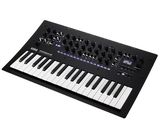Korg Minilogue XD is a 4 Voice hybrid polysynth with Unison, Chord and a powerful arpeggiator. There are 2 analogue oscillators with saw, triangle and square waveforms, and a digital oscillator with 3 modes called multi-engine. It was three modes of operation, noise, vpn (which are phase-modulated classic digital waveforms) and user, which can house up to 16 free, open source or commerical user oscillators. There is and ADSR amp envelope, and an AD envelope which can be routed to all pitches, only OSC2 pitch, or the filter cuttoff. Said filter is a digital low pass filter with resonance. The multi-engine can either be modulated by the EG or bypass it entirely. There is a single LFO with free-form, tempo and 1-shot modes, trig, square and saw waveforms which can be routed to waveshape, pitch or cutoff. The LFO can target either all oscilators, just the multi engine, or any combo of the analog oscillators. Finally, there is a decent digital filter stack with plenty of options for Reverb, Delay and other common effects such as Chorus and Ensemble. You can also add user effects just as you can add digital oscillators. Finally there is a single track 4 voice 16 step sequencer with 4 slots for motion sequencing: ANY parameter is mappable, including the multi-engine oscillator type or arp-uni-poly modes, which can open up the basic sequencer to some pretty powerful options, which could make some combinations make it seem more powerful than it actually appears on the surface.
The build quality is great, with a metal front panel, smooth yet stable knobs and clicky or springy levers. The side and back faux(?) wood finish looks and feels great. The keys are ok, coming fron a piano background i always feel a bit underwhelmed by synth keyboards but they are cenrtainly playable. The only gripe i have is that the knob on the mod-stick comes loose pretty easily, but you can just pop it back in no problem. The second issue is the tuning: it having an analogue component, it requires tuning, but the time alotted by the firmware for this process is NOT sufficient. That results in it sometimes sounding detuned, especially in the higher pitches. If you leave enough time for the components to reach their final operating temperature and tune again, then it stabilizes nicely, but that process is slow and may take up to 5 minutes until you have a reliably tuned instrument.
Using the synth as a sound design or performance instrument is easy, intuitive and fun. There are some functions buried in the menus, but there are never more than 2 levels of diving to reach anything. Plentiful shift functions and shortcuts do exist, so reading the manual would open you up to functions that are not immediately obvious, such as multiplying the LFO waveform by -1 (making the saw a ramp, or the triangle a dip for example) and many many other tricks, such as Dry/Wet control for the reverb depth.
Programming the synth is as easy as you might expect with two minor flaws: the MIDI implementation of the sequencer is a little weird and the gate times of the notes played by the sequencer are not transmitted properly but somehow only communicated as impulses, therefore using the onboard sequencer with a DAW either requires some MAX or MIDI wizardry. Personally, I tend to use the DAW sequencer when integrating it with a computer, so that's not really a problem for me.
The second problem is sadly insurmountable in some cases: while most of the times program change is instantaneous and you can switch from one sound to another in real time, switching between complex programs does take a bit of time and that has limited me somewhat.
The most important part though, other than the technical shortcomings is sound: and it is rich, creamy, wide and extensible. For an electrical engineer like me, the openness of the multi engine and the ability to hack custom effects and oscillators is a dream. There is also a healthy marketplace of both commercial and free or OSS options.
This instrument has opened me up to a whole new world of music. It is beginner friendly, as a was a total noob in the world of synthesis before it and the learning curve was definitely manageable. However, coming from a technical background which allows me to peer into how these devices are designed and what they do in terms of actual signal processing, there is a lot of potential in this device if you want to dive really deep.
Would. Definitely. Recommend.


